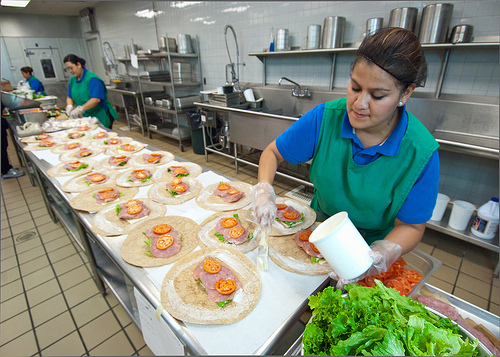The Families First Coronavirus Response Act, H.R. 6201, enables states to enact emergency measures to provide students with nutritious food during school closures. Because of H.R. 6201, many students can receive benefits for food on an electronic benefits transfer (EBT) card. They also have the option to pick up food from convenient locations such as community centers and public housing. And school food authorities (SFAs) can use federal dollars to deliver meals to students who do not have the ability to travel.
The law suspended congregate feeding requirements, allowing states to automatically provide grab-and-go meals rather than first applying to the United States Department of Agriculture (USDA) for a waiver. But states must submit additional plans and waiver requests to USDA to ensure that students get the food they need during school closures. To take full advantage of available federal benefits, state plans should be as far-reaching as the Families First Act allows.
Specifically, states should submit plans to USDA that:
1. Elect to provide Pandemic Electronic Benefits Transfer (P-EBT). P-EBT is available to all children who would have received free or reduced-price meals, but whose school closed for five or more days. Schools or school districts that implement the Community Eligibility Provision (CEP) can provide benefits to all students.
For children who already receive SNAP, the state can add benefits to an existing EBT card. For children not yet enrolled in SNAP, the state can issue a new EBT card. Notably, states can issue benefits retroactively. With P-EBT, families can buy the same foods as are available through SNAP.
State agencies may establish emergency standards for eligibility and benefit levels. Benefits should equal or exceed the free rate per meal per child. To activate P-EBT, states need to submit a plan to USDA.
2. Request an “open” site waiver to ensure USDA reimburses the state for all meals served to students. Under H.R. 6201, most SFAs will be providing meals subject to Summer Food Service Program (SFSP) rules. At SFSP “open” sites, USDA reimburses providers for all meals served to children. At “closed” sites, USDA reimburses for the meals served to children already verified as eligible for free and reduced-priced (FRP) meals. Typically, open sites are only in needy areas where 50 or more percent of children are eligible for FRP meals.
Under H.R. 6201, states can request that all sites they operate during the public health emergency are considered “open” sites, meaning USDA will reimburse for all meals served to students. Allowing providers to serve meals without prior verification will help ensure that all students, including those whose families’ economic situations have changed during this turbulent time, can access the food they need.
3. Request a waiver for time restrictions for meal service, enabling SFAs to deliver multiple meals at a time. Federal regulations (7 CFR 225.16(c)(1) and (2)) typically require meals to be served at certain times of the day, but states can submit a plan to USDA that allows SFAs to deliver meals for multiple days, up to one week at a time. These meals can be ready-to-eat or shelf-stable. H.R. 6201 lifts the cap on federal spending, allowing USDA to spend additional funds during the public health emergency. States should request that these funds cover distribution and delivery fees in their plans.
4. Claim federal reimbursements for meals served during scheduled spring breaks. According to COVID-19 Summer Food Service Program and Seamless Summer Option Meal Delivery Using Existing Authority Guidance, USDA can reimburse SFSP and Seamless Summer Option (SSO) sponsors for meals they serve during spring breaks cancelled or postponed due to COVID-19.
5. Establish plans to track actions and prepare for the future. R. 6201 requires states to submit a report to USDA within one year of the public health emergency. The report must describe how the state took advantage of federal waivers and whether those waivers improved meal service. To the extent possible, states should track the steps they are taking. States should also schedule time when the public health emergency is over to assess how USDA, their agencies, and SFAs could improve processes and develop model state plans for future USDA waivers.
